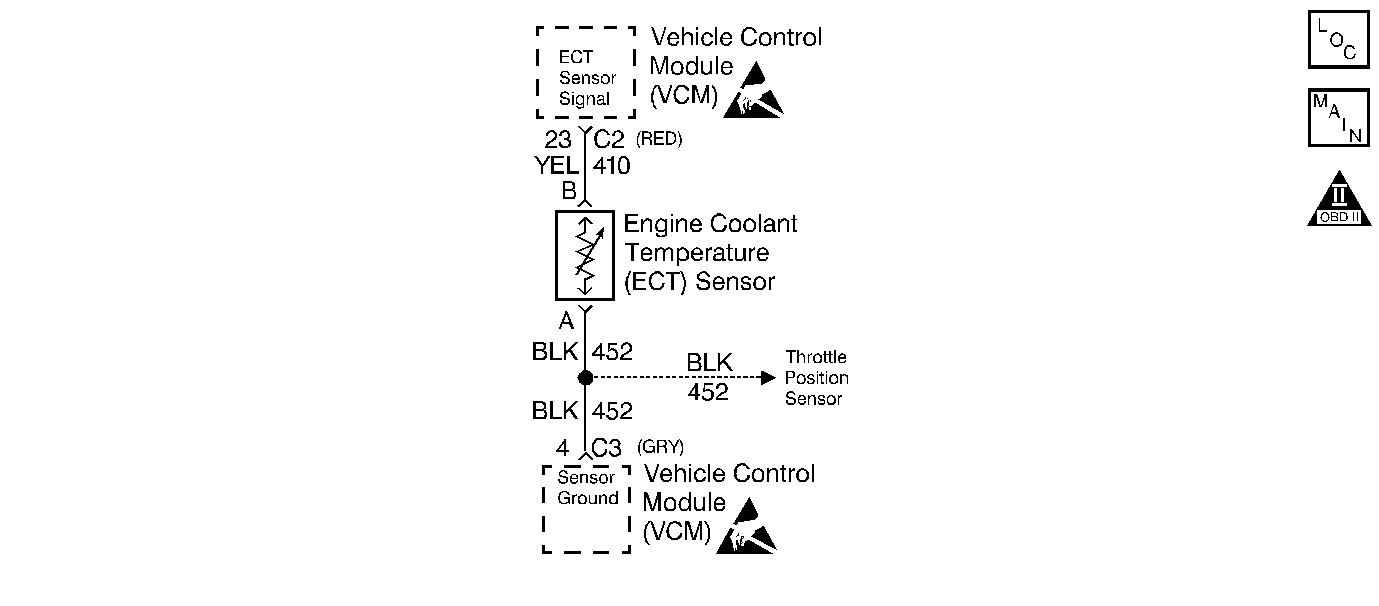
Circuit Description
The Engine Coolant Temperature (ECT) sensor is a thermistor immersed in the intake manifold cooling system passage. The VCM applies a voltage on the 5 volt reference circuit to the sensor. When the engine is cold, the sensor (thermistor) resistance is high; therefore, the VCM senses a high signal voltage, and the VCM indicates the coolant temperature. As the engine warms, the sensor resistance becomes less and the voltage drops indicating the high coolant temperature. At the normal engine operating temperature (85°C to 95°C), the voltage measures about 1.5 to 2.0 volts. This DTC is a type D DTC.
Conditions for Setting the DTC
| • | The engine run time is greater than 5 seconds. |
| • | The ECT is less than 0.25 volts (Low Resistance Pull-Up) |
| • | The ECT is less than 0.25 volts (High Resistance Pull-Up) |
Action Taken When the DTC Sets
The VCM stores the DTC in History if the VCM detects an intermittent problem.
Conditions for Clearing the MIL/DTC
The VCM turns OFF the MIL after 3 consecutive driving trips without a fault condition present. A history DTC will clear if no fault conditions have been detected for 40 warm-up cycles (the coolant temperature has risen 22°C (40°F) from the start-up coolant temperature and the engine coolant temperature exceeds 71°C (160°F) during that same ignition cycle) or the scan tool clearing feature has been used.
Diagnostic Aids
Check the harness routing for a potential short to ground in the 5 volt reference circuit.
The scan tool displays the engine temperature in degrees centigrade. After the engine is started, the temperature should rise steadily to about 90°C then stabilize when the thermostat opens.
Use the Temperature vs. Resistance Value scale to test the coolant sensor at various temperature levels in order to evaluate the possibility of a skewed or mis-scaled sensor. A skewed sensor could result in poor driveability complaints. Refer to Temperature vs Resistance .
Test Description
The numbers below refer to the step numbers on the diagnostic table.
-
If the fault is still present, engine coolant voltage will be less than 0.82 volts.
-
This test simulates a DTC P0118. If the VCM recognizes the high signal voltage (high temperature), and the scan tool reads 4.9 volts or above, the VCM and wiring are OK.
-
This test will determine if the 5 volt reference circuit is open. There should be 5 volts present at sensor connector if measured with a J 39200 . This will determine if there is a wiring problem or a faulty VCM.
Step | Action | Value(s) | Yes | No |
|---|---|---|---|---|
1 |
Important: Before clearing the DTCs, use the scan tool to record the Freeze Frame and the Failure Records for reference. This data will be lost when the Clear Info function is used. Was the Powertrain On-Board Diagnostic (OBD) System Check performed? | -- | ||
Does the scan tool display a ECT sensor voltage less than the specified value? | 0.82V | |||
Does the scan tool display a ECT sensor voltage greater than the specified value? | 4.0V | |||
Is the resistance at the specified value? | ∞ | |||
5 | The DTC is intermittent. If no additional DTCs are stored, refer to the Diagnostic Aids. If additional DTCs are stored refer to those tables first. Are any additional DTCs stored? | -- | Go to The Applicable DTC Table | |
6 | Repair the short to ground in the ECT signal circuit. Refer to Wiring Repairs in Engine Electrical. Is the action complete? | -- | -- | |
7 | Replace the ECT sensor. Refer to the Engine Coolant Temperature (ECT) Sensor Replacement . Is the action complete? | -- | -- | |
8 | Replace the VCM. Important: If the VCM is faulty, the new VCM must be programmed. Refer to VCM Replacement/Programming . Is the action complete? | -- | -- | |
9 |
Does scan tool indicate that this diagnostic Ran and Passed? | -- | ||
10 | Using the scan tool, select the Capture Info and the Review Info. Are any DTCs displayed that have not been diagnosed? | -- | Go to The Applicable DTC Table | System OK |
